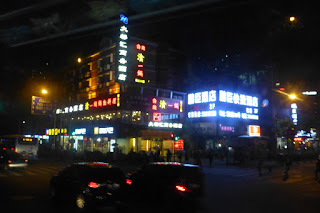On the morning
of Day 11, we visited the Lingering Garden. Occupying an area of 5.8 acres
(about 23,300 square meters), the Lingering Garden is located outside Changmen
Gate in Suzhou. Originally a classical private garden, it is one of the four
most famous gardens in China. Possessing typical Qing style, it is well-known
for the exquisite beauty of its magnificent halls, and the various sizes,
shapes, and colors of the buildings. In 1997, it was recorded on the list of
the world heritage by UNESCO.
With a history of more than 400
years, the Lingering Garden has changed hands several times. Each owner did his
best to perfect it. The garden was first built in 1593 during the Ming Dynasty
(1368-1644) by a retired official named Xu Tai. During the Qing Dynasty (1644-1911),
it was bought by Liu Shu. As a calligraphy lover, he carved masterpieces on
both sides of the corridors of the buildings. He had also collected
unusually-shaped stones in the garden. The succeeding owners followed his model
when doing restoration work. Almost demolished in the 1930s, the garden was
repaired sponsored by the government and then opened to the public.
While I'm posting a lot of
pictures of the gardens, there are many more great pictures that I didn't
include. This home and garden is truly spectacular and should be on everyone's
bucket list who visits China. I can imagine how this home and garden must have
been as close to heaven as the owners could have gotten.
 |
This small interior courtyard was used to welcome visitors and
begin their transition from the outside world. |
 |
| There are many intricate stone windows featuring glimpses of the garden. |
 |
The pathways throughout the garden were detailed with
stonework in intricate patterns that were an artwork of their own. |
 |
| The garden has many levels each offering a different view of the ponds and plantings. |
 |
| An area in the garden home for Suzhou Story Telling and Ballad Singing. |
 |
| Unusual rock formations were featured throughout the gardens. |
 |
I had a very hard time escaping from these women, who were friendly and very
eager to take pictures with me of their group and singly. The dour looking
woman on my right slapped away anyone who tried to take her place! |
 |
| Such a tranquil setting! |
 |
| Just like in the USA, EVERYONE had their phone in hand. |
 |
| One entire area of the garden was devoted to bonsai trees displayed on bench-like tables. |
 |
| There was an area devoted to rose bushes and camellias in full bloom. |
 |
| The Bonsai section |
 |
Another section had miniature "landscapes" like the one above that
contained tiny bonsai trees within them. They were so enchanting! |
 |
Despite being in the middle of an urban area, and being very crowded with
families and tourists, it was always possible to find quiet secluded nooks like this. |





























































